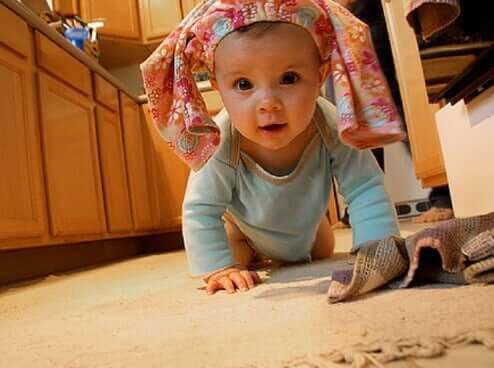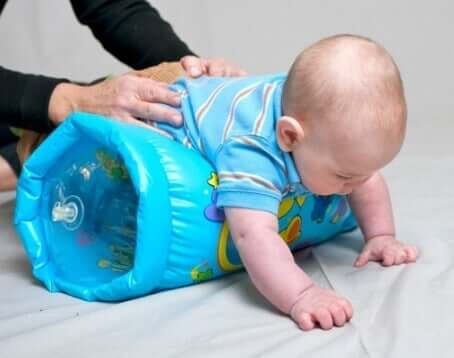7 Games to Stimulate Crawling

Watching your baby grow is an incredible experience that will fill your soul in an unsurpassable way. From the time your first hold them in your arms, you won’t stop dreaming of those important moments in their evolution. But being part of that development is a key piece for their growth. That’s why we want to tell you about some games to stimulate crawling.
This important stage of a child’s development usually occurs between seven and nine months of life. Exactly when you begin to observe that they already have the ability to support themselves sitting down, trying to shift all their weight forward, and placing their little hands in front of them in order to adopt a suitable position that allows them to move by crawling.
The crawling stage begins between seven and nine months of age.

Initial signals
During this process, you’ll observe how the so-called parachute reflex manifests itself. This consists of opening their arms as if they wanted to grab, when you bend down too quickly or if they’re about to fall. This is an important defense mechanism because it will help them avoid delicate bumps or injuries.
Crawling is a fundamental step in their psychomotor development, as it’s the step prior to walking. However, some children don’t spend much time in this position and begin to walk without waiting. If this happens to your baby, there’s nothing to worry about because it’s normal. But, if you want to be more sure, consult your pediatrician.
Babies generally begin by crawling and then move back and forth without any displacement. Later, it’s possible that they’ll move backward, as it’s much easier for them. Now, remember that each child is different and will evolve in their own way.
The crawling phase has two main objectives. The first is to grab objects that attract their attention to discover them by color and texture. The second is to learn to stand up to get on a piece of furniture or try to take their first steps, which will make them fly in their world of innocence and illusions.
7 activities to stimulate crawling
After explaining these points, we want to show you the games that will help stimulate crawling so you can accompany your baby in this process:

- A little help doesn’t hurt: In principle, babies tend to squirm around before raising their trunk. At this point, to stimulate crawling, place the sole of your hand on their feet, as a point of support, to strengthen their legs.
- The towel game: Roll up a sheet or a blanket in the shape of a roller, hold your child by the trunk and place them on it. Once you’ve done this, push them back and forth so that they find support with their hands.
- A fun obstacle: Sit on the floor and spread your legs, place a toy on one side and allow them to try to climb over your leg. Repeat, little by little, until they reach the object of interest.
- Like a marathon runner: Just like the previous exercise, you can put down small barriers (cushions, tunnels, or rolled blankets) to motivate them to move to look for what catches their attention.
- Object at a distance: Find a toy with many colors or lights, place it at a distance, and invite your child to grab it. Be cheerful, enthusiastic, and very patient. Don’t forget that this can go very slow or very fast.
- Play tag: Get into a crawling position and ask your child to catch you, while you move to another place. It’s also very good to have small races where you let them win.
- Up and down: Learning to crawl isn’t the only challenge that small children face, they also have to figure out how to get off high places. If you see them poking their heads out to get off first, move their whole body to the side and move their leg down.
The importance of crawling
Many specialists insist that we shouldn’t pressure our children to crawl. Their body will demonstrate its own capabilities, without the need to force any element. Crawling depends directly on the maturity of their body.
Crawling should be spontaneous and natural in babies.
By crawling, they broaden their visual field and distinguish dimensions; they perceive the differences between textures, surfaces, and level changes, discover depth perception, and achieve balance and independence.
The growth of a child is something natural and spontaneous. Enjoy these moments that are never repeated and keep them as a treasure within your heart.
Watching your baby grow is an incredible experience that will fill your soul in an unsurpassable way. From the time your first hold them in your arms, you won’t stop dreaming of those important moments in their evolution. But being part of that development is a key piece for their growth. That’s why we want to tell you about some games to stimulate crawling.
This important stage of a child’s development usually occurs between seven and nine months of life. Exactly when you begin to observe that they already have the ability to support themselves sitting down, trying to shift all their weight forward, and placing their little hands in front of them in order to adopt a suitable position that allows them to move by crawling.
The crawling stage begins between seven and nine months of age.

Initial signals
During this process, you’ll observe how the so-called parachute reflex manifests itself. This consists of opening their arms as if they wanted to grab, when you bend down too quickly or if they’re about to fall. This is an important defense mechanism because it will help them avoid delicate bumps or injuries.
Crawling is a fundamental step in their psychomotor development, as it’s the step prior to walking. However, some children don’t spend much time in this position and begin to walk without waiting. If this happens to your baby, there’s nothing to worry about because it’s normal. But, if you want to be more sure, consult your pediatrician.
Babies generally begin by crawling and then move back and forth without any displacement. Later, it’s possible that they’ll move backward, as it’s much easier for them. Now, remember that each child is different and will evolve in their own way.
The crawling phase has two main objectives. The first is to grab objects that attract their attention to discover them by color and texture. The second is to learn to stand up to get on a piece of furniture or try to take their first steps, which will make them fly in their world of innocence and illusions.
7 activities to stimulate crawling
After explaining these points, we want to show you the games that will help stimulate crawling so you can accompany your baby in this process:

- A little help doesn’t hurt: In principle, babies tend to squirm around before raising their trunk. At this point, to stimulate crawling, place the sole of your hand on their feet, as a point of support, to strengthen their legs.
- The towel game: Roll up a sheet or a blanket in the shape of a roller, hold your child by the trunk and place them on it. Once you’ve done this, push them back and forth so that they find support with their hands.
- A fun obstacle: Sit on the floor and spread your legs, place a toy on one side and allow them to try to climb over your leg. Repeat, little by little, until they reach the object of interest.
- Like a marathon runner: Just like the previous exercise, you can put down small barriers (cushions, tunnels, or rolled blankets) to motivate them to move to look for what catches their attention.
- Object at a distance: Find a toy with many colors or lights, place it at a distance, and invite your child to grab it. Be cheerful, enthusiastic, and very patient. Don’t forget that this can go very slow or very fast.
- Play tag: Get into a crawling position and ask your child to catch you, while you move to another place. It’s also very good to have small races where you let them win.
- Up and down: Learning to crawl isn’t the only challenge that small children face, they also have to figure out how to get off high places. If you see them poking their heads out to get off first, move their whole body to the side and move their leg down.
The importance of crawling
Many specialists insist that we shouldn’t pressure our children to crawl. Their body will demonstrate its own capabilities, without the need to force any element. Crawling depends directly on the maturity of their body.
Crawling should be spontaneous and natural in babies.
By crawling, they broaden their visual field and distinguish dimensions; they perceive the differences between textures, surfaces, and level changes, discover depth perception, and achieve balance and independence.
The growth of a child is something natural and spontaneous. Enjoy these moments that are never repeated and keep them as a treasure within your heart.
All cited sources were thoroughly reviewed by our team to ensure their quality, reliability, currency, and validity. The bibliography of this article was considered reliable and of academic or scientific accuracy.
- López, S. (2012). La importancia del Gateo. Psicoactua,(30), 2-1. http://www.psicoactua.com/webcms/usuario/documentos/20121105174143_Importancia%20del%20gateo.pdf
- Ojeda Alberca, E. (2018). El gateo en el desarrollo cognitivo en niños menores de 2 años. http://repositorio.untumbes.edu.pe/handle/UNITUMBES/731
- Quipo Guaranda, J. M. (2017). La importancia del gateo y su incidencia en la escritura de las niñas y niños del Centro Infantil del Buen Vivir Jilgueritos de la parroquia San Francisco de Borja, cantón Quijos, provincia de Napo (Bachelor’s thesis, Universidad Técnica de Ambato. Facultad de Ciencias Humanas y de la Educación. Carrera de Parvularia). https://repositorio.uta.edu.ec/handle/123456789/24919
This text is provided for informational purposes only and does not replace consultation with a professional. If in doubt, consult your specialist.








